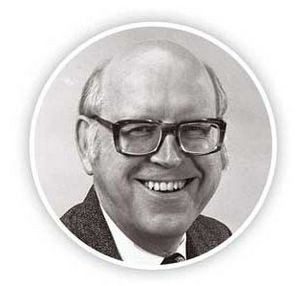Allen Newell facts for kids
Quick facts for kids
Allen Newell
|
|
|---|---|
 |
|
| Born | March 19, 1927 |
| Died | July 19, 1992 (aged 65) |
| Alma mater | Stanford University Princeton University Carnegie Mellon University |
| Known for | Information Processing Language Logic Theorist General Problem Solver Soar Unified Theories of Cognition |
| Awards | A.M. Turing Award (1975) IJCAI Award for Research Excellence (1989) IEEE Emanuel R. Piore Award (1990) National Medal of Science (1992) Louis E. Levy Medal (1992) |
| Scientific career | |
| Fields | Computer science Cognitive psychology |
| Institutions | Carnegie Mellon University |
| Doctoral advisor | Herbert A. Simon |
| Doctoral students | Hans Berliner Stuart Card John E. Laird Frank Ritter Milind Tambe |
Allen Newell (born March 19, 1927 – died July 19, 1992) was an American scientist. He was a pioneer in computer science and cognitive psychology. This means he studied how computers can "think" and how humans think.
Newell worked at the RAND Corporation and Carnegie Mellon University. He helped create the Information Processing Language in 1956. He also developed two of the first AI programs. These were the Logic Theory Machine (1956) and the General Problem Solver (1957). He worked on these with his partner, Herbert A. Simon.
In 1975, Newell and Simon won the Turing Award. This is a very important award in computer science. They received it for their big contributions to artificial intelligence and understanding how people think.
Contents
Allen Newell's Early Life and Studies
Allen Newell finished his first degree in physics from Stanford University in 1949. After that, he studied mathematics at Princeton University from 1949 to 1950.
During his studies, he learned about game theory. This made him realize he liked combining experiments with theories. He preferred this to just doing pure math.
In 1950, he joined the RAND Corporation. There, he studied how the Air Force managed its supplies. His work helped create new ideas about how organizations work. Later, he earned his PhD from Carnegie Mellon University. His advisor was Herbert A. Simon.
Newell then studied how small groups of people make decisions. He found that these small experiments were not always accurate. So, he joined a team to study flight crews at an Air Force station. They built a simulator to watch how crews made decisions. From this, Newell realized that handling information is key to how organizations operate.
How Allen Newell Helped Create AI
In 1954, Allen Newell attended a seminar. There, he heard about a computer program that could learn to recognize letters. This made him believe that computers could be made to be intelligent. He thought they could even learn and adapt.
With this idea, Newell wrote about a "chess machine" in 1955. This paper described how a computer program could play chess like a human.
His work caught the eye of Herbert A. Simon. Together with programmer J. C. Shaw, they created the Logic Theorist. This is seen as one of the first true artificial intelligence programs. Newell's work on this program helped start the whole field of AI.
He invented several important things:
- List processing: A way of organizing computer information that AI programs still use.
- Means-ends analysis: A method for solving problems by breaking them into smaller steps.
- Heuristics: Smart shortcuts that help computers find solutions faster.
Newell and his team showed the Logic Theorist at the Dartmouth workshop in 1956. This meeting is often called the "birth of artificial intelligence." Many researchers who attended became leaders in AI.
Later Important Work
Newell and Simon continued to work together for many years. They started an AI lab at Carnegie Mellon University. They created many important programs and ideas.
One of their famous programs was the General Problem Solver. This program used "means-ends analysis" to solve different kinds of problems. They also came up with the idea that all intelligent behavior can be explained by how symbols are handled.
Newell's work led to the creation of Soar. This is a special computer system designed to think like humans. He also published his "unified theory of cognition" in 1990. He worked on improving these ideas until he passed away. The study of "cognitive architectures," which he started, is still an active area in AI today.
Awards and Honors
Allen Newell received many awards for his important work:
- 1971 — Harry Goode Memorial Award
- 1972 — Elected to the National Academy of Sciences
- 1975 — Turing Award (with Herbert A. Simon)
- 1980 — Elected to the National Academy of Engineering
- 1980 — First President of the American Association for Artificial Intelligence
- 1981 — Computer Pioneer Award from the IEEE Computer Society
- 1989 — Award for Research Excellence, International Joint Conference on Artificial Intelligence
- 1992 — U.S. National Medal of Science
- 1992 — Louis E. Levy Medal
Two awards are named in his honor: the ACM - AAAI Allen Newell Award and the Award for Research Excellence at Carnegie Mellon University.
See also
 In Spanish: Allen Newell para niños
In Spanish: Allen Newell para niños

